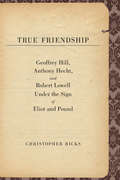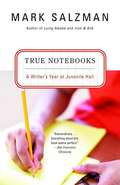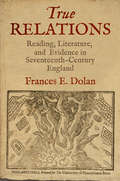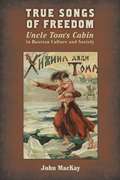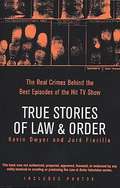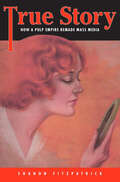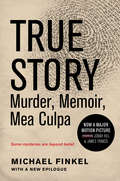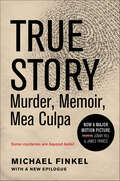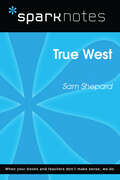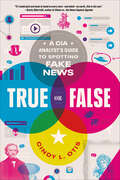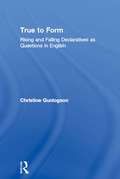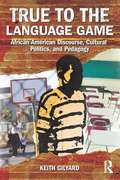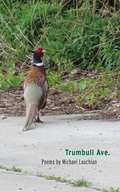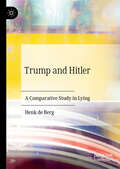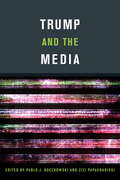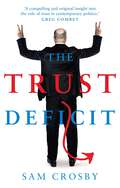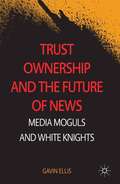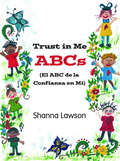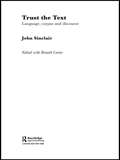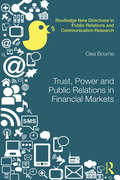- Table View
- List View
True Friendship: Geoffrey Hill, Anthony Hecht, and Robert Lowell Under the Sign of Eliot and Pound
by Christopher RicksTrue Friendship looks closely at three outstanding poets of the past half-century--Geoffrey Hill, Anthony Hecht, and Robert Lowell--through the lens of their relation to their two predecessors in genius, T. S. Eliot and Ezra Pound. The critical attention then finds itself reciprocated, with Eliot and Pound being in their turn contemplated anew through the lenses of their successors. Hill, Hecht, and Lowell are among the most generously alert and discriminating readers, as is borne out not only by their critical prose but (best of all) by their acts of new creation, those poems of theirs that are thanks to Eliot and Pound. "Opposition is true Friendship." So William Blake believed, or at any rate hoped. Hill, Hecht, and Lowell demonstrate many kinds of friendship with Eliot and Pound: adversarial, artistic, personal. In their creative assent and dissent, the imaginative literary allusions--like other, wider forms of influence--are shown to constitute the most magnanimous of welcomes and of tributes.
True Notebooks: A Writer's Year at Juvenile Hall
by Mark SalzmanThe author teaches the adolescent inmates at juvenile hall whose crimes vary from minor ones to murder.
True Relations
by Frances E. DolanIn the motley ranks of seventeenth-century print, one often comes upon the title True Relation. Purportedly true relations describe monsters, miracles, disasters, crimes, trials, and apparitions. They also convey discoveries achieved through exploration or experiment. Contemporaries relied on such accounts for access to information even as they distrusted them; scholars today share both their dependency and their doubt. What we take as evidence, Frances E. Dolan argues, often raises more questions than it answers. Although historians have tracked dramatic changes in evidentiary standards and practices in the period, these changes did not solve the problem of how to interpret true relations or ease the reliance on them. The burden remains on readers.Dolan connects early modern debates about textual evidence to recent discussions of the value of seventeenth-century texts as historical evidence. Then as now, she contends, literary techniques of analysis have proven central to staking and assessing truth claims. She addresses the kinds of texts that circulated about three traumatic events--the Gunpowder Plot, witchcraft prosecutions, and the London Fire--and looks at legal depositions, advice literature, and plays as genres of evidence that hover in a space between fact and fiction. Even as doubts linger about their documentary and literary value, scholars rely heavily on them. Confronting and exploring these doubts, Dolan makes a case for owning up to our agency in crafting true relations among the textual fragments that survive.
True Songs of Freedom
by John MackayHarriet Beecher Stowes 1852 antislavery novel Uncle Toms Cabin was the nineteenth centurys best-selling novel worldwide; only the Bible outsold it. It was known not only as a book but through stage productions, films, music, and commercial advertising as well. But how was Stowes novel one of the watershed works of world literature actually received outside of the American context? True Songs of Freedom explores one vital sphere of Stowes influence: Russia and the Soviet Union, from the 1850s to the present day. Due to Russias own tradition of rural slavery, the vexed entwining of authoritarianism and political radicalism throughout its history, and (especially after 1945) its prominence as the superpower rival of the United States, Russia developed a special relationship to Stowes novel during this period of rapid societal change. Uncle Toms Cabin prompted widespread reflections on the relationship of Russian serfdom to American slavery, on the issue of race in the United States and at home, on the kinds of writing appropriate for children and peasants learning to read, on the political function of writing, and on the values of Russian educated elites who promoted, discussed, and fought over the book for more than a century. By the time of the Soviet Unions collapse in 1991, Stowes novel was probably better known by Russians than by readers in any other country. John MacKay examines many translations and rewritings of Stowes novel; plays, illustrations, and films based upon it; and a wide range of reactions to it by figures famous (Leo Tolstoy, Ivan Turgenev, Marina Tsvetaeva) and unknown. In tracking the reception of Uncle Toms Cabin across 150 years, he engages with debates over serf emancipation and peasant education, early Soviet efforts to adapt Stowes deeply religious work of protest to an atheistic revolutionary value system, the novels exploitation during the years of Stalinist despotism, Cold War anti-Americanism and antiracism, and the postsocialist consumerist ethos.
True Stories of Law & Order
by Kevin Dwyer Jure FiorilloTrue Stories of Law & Order reveals the fascinating and shocking facts behind 25 of the hit show's most popular episodes - from the incredible account of how a woman's repressed memory leads to the solving of a 30-year-old cold case to the high-profile investigation of tranvestite millionaire Robert Durst. And just like in Law & Order, the actual crime is just the beginning, as you follow these cases from the initial stages of the investigation through the trial and up to the often controversial verdicts. Part of the reason millions of fans tune in to Law & Order is the gritty realism of its storytelling. The monumentally popular show has included many episodes inspired by actual cases ripped from the headlines - true crimes that are often stranger and more chilling than fiction.
True Story: How a Pulp Empire Remade Mass Media
by Shanon FitzpatrickThe larger-than-life story of Bernarr Macfadden, a bodybuilder who turned his obsession with muscles, celebrity, and confession into a publishing empire that transformed global media.In True Story, Shanon Fitzpatrick tells the unlikely story of an orphan from the Ozarks who became one of history’s most powerful media moguls. Born in 1868 in Mill Spring, Missouri, Bernarr Macfadden turned to bodybuilding to transform himself from a sickly “boy” into a creature of masculine perfection. He then channeled his passion into the magazine Physical Culture, capitalizing on the wider turn-of-the-century mania for fitness. Macfadden Publications soon become a pioneer in mass media, helping to inaugurate our sensational, confessional, and body-obsessed global marketplace.With publications like True Story, a magazine purportedly written and edited by its own readers, as well as scores of romance, crime, and fan magazines, Macfadden specialized in titles that targeted women, immigrants, and the working class. Although derided as pulp by critics of the time, Macfadden’s publications were not merely profitable. They were also influential. They championed reader engagement and interactivity long before these were buzzwords in the media industry, breaking down barriers between producers and consumers of culture. At the same time, Macfadden Publications inspired key elements of modern media strategy by privileging rapid production of new content and equally rapid disintegration and reconfiguration of properties in the face of shifting market conditions.No less than the kings of Hollywood and Madison Avenue, Macfadden was a crucial player in shaping American consumer culture and selling it to the world at large. Though the Macfadden media empire is overlooked today, its legacies are everywhere, from true-crime journalism to celebrity gossip rags and fifteen-minute abs.
True Story: Murder, Memoir, Mea Culpa
by Michael FinkelIn the haunting tradition of Joe McGinniss's Fatal Vision and Mikal Gilmore's Shot in the Heart, True Story: Murder, Memoir, Mea Culpa weaves a spellbinding tale of murder, love, and deceit with a deeply personal inquiry into the slippery nature of truth. The story begins in February of 2002, when a reporter in Oregon contacts New York Times Magazine writer Michael Finkel with a startling piece of news. A young, highly intelligent man named Christian Longo, on the FBI's Ten Most Wanted list for killing his entire family, has recently been captured in Mexico, where he'd taken on a new identity-Michael Finkel of the New York Times. The next day, on page A-3 of the Times, comes another bit of troubling news: a note, written by the paper's editors, explaining that Finkel has falsified parts of an investigative article and has been fired. This unlikely confluence sets the stage for a bizarre and intense relationship. After Longo's arrest, the only journalist the accused murderer will speak with is the real Michael Finkel. And as the months until Longo's trial tick away, the two men talk for dozens of hours on the telephone, meet in the jailhouse visiting room, and exchange nearly a thousand pages of handwritten letters. With Longo insisting he can prove his innocence, Finkel strives to uncover what really happened to Longo's family, and his quest becomes less a reporting job than a psychological cat-and-mouse game-sometimes redemptively honest, other times slyly manipulative. Finkel's pursuit pays off only at the end, when Longo, after a lifetime of deception, finally says what he wouldn't even admit in court-the whole, true story. Or so it seems.
True Story: Murder, Memoir, Mea Culpa
by Michael FinkelIn the haunting tradition of Joe McGinniss's Fatal Vision and Mikal Gilmore's Shot in the Heart, True Story: Murder, Memoir, Mea Culpa weaves a spellbinding tale of murder, love, and deceit with a deeply personal inquiry into the slippery nature of truth.The story begins in February of 2002, when a reporter in Oregon contacts New York Times Magazine writer Michael Finkel with a startling piece of news. A young, highly intelligent man named Christian Longo, on the FBI's Ten Most Wanted list for killing his entire family, has recently been captured in Mexico, where he'd taken on a new identity--Michael Finkel of the New York Times.The next day, on page A-3 of the Times, comes another bit of troubling news: a note, written by the paper's editors, explaining that Finkel has falsified parts of an investigative article and has been fired. This unlikely confluence sets the stage for a bizarre and intense relationship. After Longo's arrest, the only journalist the accused murderer will speak with is the real Michael Finkel. And as the months until Longo's trial tick away, the two men talk for dozens of hours on the telephone, meet in the jailhouse visiting room, and exchange nearly a thousand pages of handwritten letters.With Longo insisting he can prove his innocence, Finkel strives to uncover what really happened to Longo's family, and his quest becomes less a reporting job than a psychological cat-and-mouse game--sometimes redemptively honest, other times slyly manipulative. Finkel's pursuit pays off only at the end, when Longo, after a lifetime of deception, finally says what he wouldn't even admit in court--the whole, true story. Or so it seems.
True Story: Murder, Memoir, Mea Culpa
by Michael FinkelIn the haunting tradition of Joe McGinniss's Fatal Vision and Mikal Gilmore's Shot in the Heart, True Story: Murder, Memoir, Mea Culpa weaves a spellbinding tale of murder, love, and deceit with a deeply personal inquiry into the slippery nature of truth.The story begins in February of 2002, when a reporter in Oregon contacts New York Times Magazine writer Michael Finkel with a startling piece of news. A young, highly intelligent man named Christian Longo, on the FBI's Ten Most Wanted list for killing his entire family, has recently been captured in Mexico, where he'd taken on a new identity--Michael Finkel of the New York Times.The next day, on page A-3 of the Times, comes another bit of troubling news: a note, written by the paper's editors, explaining that Finkel has falsified parts of an investigative article and has been fired. This unlikely confluence sets the stage for a bizarre and intense relationship. After Longo's arrest, the only journalist the accused murderer will speak with is the real Michael Finkel. And as the months until Longo's trial tick away, the two men talk for dozens of hours on the telephone, meet in the jailhouse visiting room, and exchange nearly a thousand pages of handwritten letters.With Longo insisting he can prove his innocence, Finkel strives to uncover what really happened to Longo's family, and his quest becomes less a reporting job than a psychological cat-and-mouse game--sometimes redemptively honest, other times slyly manipulative. Finkel's pursuit pays off only at the end, when Longo, after a lifetime of deception, finally says what he wouldn't even admit in court--the whole, true story. Or so it seems.
True Story: Murder, Memoir, Mea Culpa
by Michael FinkelThe improbable but true story of a man accused of murdering his entire family and the journalist he impersonated while on the runIn 2001, Mike Finkel was on top of the world: young, talented, and recently promoted to a plum job at the New York Times Magazine. Then he made an irremediable slip: Under extraordinary pressure to keep producing blockbuster stories, he fabricated parts of an article. Caught and excommunicated from the Times, he retreated to his home in Montana, swearing off any contact with the media. When the phone rang, though, he couldn’t resist. At the other end was a reporter from the San Francisco Chronicle, whom Finkel congratulated on being the first in what was sure to be a long and bloodthirsty line of media watchdogs. The reporter was puzzled. In Waldport, Oregon, Christian Longo had killed his young wife and three children and dumped their bodies into the bay. With a stolen credit card, he fled south, making his way to Cancun, where he lived for several weeks under an assumed identity: Michael Finkel, journalist for the New York Times. True Story is the tale of a bizarre and convoluted collision between fact and fiction, and a meditation on the slippery nature of truth. When Finkel contacts Longo in jail, the two men begin a close and complex relationship. Over the course of a year, they exchange long letters and weekly phone calls, playing out a cat-and-mouse game in which it’s never quite clear if the pursuer is Finkel or Longo—or both. Finkel’s dogged pursuit of the true story pays off only at the end, in the gripping trial scenes in which Longo, after a lifetime of deception, finally tells the whole truth. Or so he says.
True West (SparkNotes Literature Guide Series)
by SparkNotesTrue West (SparkNotes Literature Guide) by Sam Shepard Making the reading experience fun! Created by Harvard students for students everywhere, SparkNotes is a new breed of study guide: smarter, better, faster. Geared to what today's students need to know, SparkNotes provides: *Chapter-by-chapter analysis *Explanations of key themes, motifs, and symbols *A review quiz and essay topicsLively and accessible, these guides are perfect for late-night studying and writing papers
True or False: A CIA Analyst's Guide to Spotting Fake News
by Cindy L. Otis"If I could pick one book to hand to every teen—and adult—on earth, this is the one. True or False is accessible, thorough, and searingly honest, and we desperately needed it." —Becky Albertalli, author of Simon vs. the Homo Sapiens Agenda A former CIA analyst unveils the true history of fake news and gives readers tips on how to avoid falling victim to it in this highly designed informative YA nonfiction title. "Fake news" is a term you’ve probably heard a lot in the last few years, but it’s not a new phenomenon. From the ancient Egyptians to the French Revolution to Jack the Ripper and the founding fathers, fake news has been around as long as human civilization. But that doesn’t mean that we should just give up on the idea of finding the truth.In True or False, former CIA analyst Cindy Otis will take readers through the history and impact of misinformation over the centuries, sharing stories from the past and insights that readers today can gain from them. Then, she shares lessons learned in over a decade working for the CIA, including actionable tips on how to spot fake news, how to make sense of the information we receive each day, and, perhaps most importantly, how to understand and see past our own information biases, so that we can think critically about important issues and put events happening around us into context.True or False includes a wealth of photo illustrations, informative inserts, and sidebars containing interesting facts and trivia sure to engage readers in critical thinking and analysis.This title has common core connections.
True to Form: Rising and Falling Declaratives as Questions in English (Outstanding Dissertations in Linguistics)
by Christine GunlogsonThis book is concerned with the meaning and use of two kinds of declarative sentences:1) It's raining?2) It's raining.The difference between (1) and (2) is intonational: (1) has a final rise--indicated by the question mark--while (2) ends with a fall.Christine Gunlogson's central claim is that the meaning and use of both kinds of sentences must be understood in terms of the meaning of their defining formal elements, namely declarative sentence type and rising versus falling intonation. Gunlogson supports that claim through an investigation of the use of declaratives as questions. On one hand, Gunlogson demonstrates that rising and falling declaratives share an aspect of conventional meaning attributable to their declarative form, distinguishing them both from the corresponding polar interrogative (Is it raining?) and constraining their use as questions. On the other hand, since (1) and (2) constitute a minimal pair, differing only in intonation, systematic differences in character and function between them--in particular, the relative "naturalness" of (1) as a question compared to (2) --must be located in the contrast between the fall and the rise. To account for these two sets of differences, Gunlogson gives a compositional account of rising and falling declaratives under which declarative form expresses commitment to the propositional content of the declarative. Rising versus falling intonation on declaratives is responsible for attribution of the commitment to the Addressee versus the Speaker, respectively. The result is an inherent contextual "bias" associated with declaratives, which constitutes the crucial point of difference with interrogatives. The compositional analysis is implemented in the framework of context update semantics (Heim 1982 and others), using an articulated version of the Common Ground (Stalnaker 1978) that distinguishes the commitments of the individual discourse participants.Restrictions on the use of declaratives as questions, as well as differences between rising and falling declaratives as questions, are shown to follow from this account. Gunlogson argues that neither rising nor falling declaratives are inherently questioning--rather, the questioning function of declaratives arises through the interaction of sentence type, intonation, and context.
True to the Language Game: African American Discourse, Cultural Politics, and Pedagogy
by Keith GilyardIn True to the Language Game, Keith Gilyard, one of the major African American figures to emerge in language and cultural studies, makes his most seminal work available in one volume. This collection of new and previously published essays contains Gilyard’s most relevant scholarly contributions to deliberations about linguistic diversity, cultural identity, critical literacy, writing instruction, literary texts, and popular culture. The volume also features contemporary treatises on such timely topics as "students’ right to their own language," code-switching pedagogy, and political discourse surrounding the rise of Barack Obama. Gilyard weaves together serious analysis, theoretical work, policy discussions, and personal reflections on the interplay of language, literacy, and social justice to make True to the Language Game essential reading for students and scholars in rhetorical studies, composition studies, applied linguistics, and education.
Trumbull Ave. (Made in Michigan Writers Series)
by Michael LauchlanThe well-crafted lines in Michael Lauchlan's Trumbull Ave. are peopled by welders, bricklayers, gas meter readers, nurses, teachers, cement masons, and street kids. Taken together, they evoke a place--Detroit--in its bustling working-class past and changeable present moment. Lauchlan works in the narrative tradition of Robert Frost and Edwin Arlington Robinson but takes more recent influence from Philip Levine, Thomas Lux, and Ellen Voigt in presenting first- and third-person meditations on work, mortality, romance, childish exuberance, and the realities of time. Lauchlan presents snapshots from the past--a widowed mother bakes bread during the Depression, a welder sends his son to war in the 1940s, a bounding dog runs into a chaotic street in 1981, and a narrator visits a decaying Victorian house in 1993--with an impressive raw simplicity of language and a regular, unrhymed meter. Lauchlan pays close attention to work in many settings, including his own classroom, a plumber's damp cellar, a nurse's hospital ward, and a waitress's Chinese restaurant dining room. He also astutely observes the natural world alongside the built environment, bringing city pheasants, elm trees, buzzing cicadas, starry skies, and long grass into conversation with his narrators' interior and exterior landscapes. Lauchlan's poems reveal the layered complexity of human experiences in vivid, relatable characters and recurrent themes that feel both familiar and serious. All readers of poetry will enjoy the musical and vivid verse in Trumbull Ave.
Trump and Autobiography: Corporate Culture, Political Rhetoric, and Interpretation (Routledge Focus on Literature)
by Nicholas K. MohlmannThe 1970s and 1980s heralded the rise of neoliberalism in United States culture, fundamentally reshaping life and work in the United States. Corporate culture increasingly penetrated other aspects of American life through popular press CEO autobiographies and management books that encouraged individuals to understand their lives in corporate terms. Propelled into the public eye by the publication of 1989’s The Art of the Deal, ostensibly a CEO autobiography, Donald Trump has made a career out of reversing the autobiographical impulse, presenting an image of his life that meets his narrative needs. While many scholars have sought a political precedent for Trump’s rise to power, this book argues that Trump’s aesthetics and life production uniquely primed him for populist political success through their reliance on the tropes of popular corporate culture. Trump and Autobiography contextualizes Trump’s autobiographical works as an extension of the popular corporate culture of the 1980s in order to examine how Trump constructs an image of himself that is indebted to the forms, genres, and mechanisms of corporate speech and narrative. Ultimately, this book suggests that Trump’s appeal and resilience rest in his ability to signify as though he is a corporation, revealing the degree to which corporate culture has reshaped American society’s interpretive processes.
Trump and Hitler: A Comparative Study in Lying
by Henk de BergThis book compares Trump and Hitler as political performance artists. It explores their populist self-staging and rhetorical strategies and explains how they connected with their respective audiences. It also analyses the two men’s character, work ethic, and management style. In addition, the book addresses seemingly peripheral issues like the reasons behind Hitler’s toothbrush moustache and Trump’s hairstyle. By demystifying Hitler and Trump, the author throws new light on both of them.
Trump and the Media
by Zizi Papacharissi Pablo BoczkowskiThe election of Donald Trump and the great disruption in the news and social media. Donald Trump's election as the 45th President of the United States came as something of a surprise—to many analysts, journalists, and voters. The New York Times's The Upshot gave Hillary Clinton an 85 percent chance of winning the White House even as the returns began to come in. What happened? And what role did the news and social media play in the election? In Trump and the Media, journalism and technology experts grapple with these questions in a series of short, thought-provoking essays. Considering the disruption of the media landscape, the disconnect between many voters and the established news outlets, the emergence of fake news and “alternative facts,” and Trump's own use of social media, these essays provide a window onto broader transformations in the relationship between information and politics in the twenty-first century. The contributors find historical roots to current events in Cold War notions of "us" versus "them," trace the genealogy of the assault on facts, and chart the collapse of traditional news gatekeepers. They consider such topics as Trump's tweets (diagnosed by one writer as “Twitterosis”) and the constant media exposure given to Trump during the campaign. They propose photojournalists as visual fact checkers (“lessons of the paparazzi”) and debate whether Trump's administration is authoritarian or just authoritarian-like. Finally, they consider future strategies for the news and social media to improve the quality of democratic life. Contributors Mike Ananny, Chris W. Anderson, Rodney Benson, Pablo J. Boczkowski, danah boyd, Robyn Caplan, Michael X. Delli Carpini, Josh Cowls, Susan J. Douglas, Keith N. Hampton, Dave Karpf, Daniel Kreiss, Seth C. Lewis, Zoey Lichtenheld, Andrew L. Mendelson, Gina Neff, Zizi Papacharissi, Katy E. Pearce, Victor Pickard, Sue Robinson, Adrienne Russell, Ralph Schroeder, Michael Schudson, Julia Sonnevend, Keren Tenenboim-Weinblatt, Tina Tucker, Fred Turner, Nikki Usher, Karin Wahl-Jorgensen, Silvio Waisbord, Barbie Zelizer
Trump’s Media War
by Andrew Hoskins William Merrin Catherine HapperThe election of Donald Trump as US President in 2016 seemed to catch the world napping. Like the vote for Brexit in the UK, there seemed to be a new de-synchronicity – a huge reality gap – between the unfolding of history and the mainstream news media’s interpretations of and reporting of contemporary events. Through a series of short, sharp interventions from academics and journalists, this book interrogates the emergent media war around Donald Trump. A series of interconnected themes are used to set an agenda for exploration of Trump as the lynch-pin in the fall of the liberal mainstream and the rise of the right media mainstream in the USA. By exploring topics such as Trump’s television celebrity, his presidential candidacy and data-driven election campaign, his use of social media, his press conferences and combative relationship with the mainstream media, and the question of ‘fake news’ and his administration’s defence of ‘alternative facts’, the contributors rally together to map the parallels of the seemingly momentous and continuing shifts in the wider relationship between media and politics.
Trust Deficit
by Sam CrosbyTrust is the most powerful weapon in the political arsenal. It can pierce an opponent's armour or deflect the most ferocious attack. It can explain difficult policies, and become a well of goodwill that politicians can draw from in their darkest hours. Yet despite its great value we are resigned to the idea that trust in politics will continue to decline.Drawing on contemporary political stories and examples, The Trust Deficit shows us how faith in our politicians has been eroded but how it can be rebuilt.Julia Gillard's pledge that there wouldn't be a carbon tax and Tony Abbott's promise of no cuts to health or education saw a collapse in their governments' levels of support.By breaking trust down to its elements—reliability and competence, openness and honesty—we see how recent leaders established trust and used it to their political advantage.
Trust Ownership and the Future of News
by Gavin EllisCrumbling business models mean news media structures must change. Gavin Ellis explores the past and present use of newspaper trusts - drawing on case studies such as the Guardian, the Irish Times and the Pulitzer Prize winning Tampa Bay Times - to make the case for a form of ownership dedicated to sustaining high quality journalism.
Trust in Me ABCs: (El ABC de la Confianza en Mi)
by Shanna LawsonIt is an awesome responsibility to be a parent. We all want the very best for our children. In Proverbs 22:6 it states, "Train up a child in the way he should go, and when he is old he will not depart from it." Finally, it's here, the book that can guide you with those essential pieces to pour into your child's heart.
Trust the Text: Language, Corpus and Discourse
by John SinclairJohn Sinclair is one of the major figures in applied linguistics and his work is essential study for students.This accessible book collects in one volume Sinclair's key papers on written discourse structure, lexis patterns, phraseology, corpus analysis, lexicography and linguistic theory from the 1990s. All the papers have been edited and updated for this book. The clear and accessible introduction helps students to navigate his key themes and arguments, making the volume an ideal companion for those coming to Sinclair's more recent writings for the first time.
Trust, Power and Public Relations in Financial Markets (Routledge New Directions in PR & Communication Research)
by Clea BourneThe public relations profession positions itself as expert in building trust throughout global markets, particularly after crisis strikes. Successive crises have tainted financial markets in recent years. Calls to restore trust in finance have been particularly pressing, given trust’s crucial role as lubricant in global financial engines. Nonetheless, years after the global financial crisis, trust in financial markets remains both tenuous and controversial. This book explores PR in financial markets, posing a fundamental question about PR professionals as would-be ‘trust strategists’. If PR promotes its expertise in building and restoring trust, how can it ignore its potential role in losing trust in the first place? Drawing on examples from state finance, international lending agencies, trade bodies, financial institutions and consumer groups in mature and emerging financial centres, this book explores the wide-ranging role of PR in financial markets, including: State finance and debt capital markets Investor relations, M&A and IPOs Corporate communications for financial institutions Product promotion and consumer finance Financial trade associations and lobbying Consumerism and financial activism. Far reaching and challenging, this innovative book will be essential reading for researchers, advanced students and professionals in PR, communication and finance.
Trusting Performance
by Naomi RokotnitzAn epistemological inquiry into the dynamics of interpersonal trust-relations, combining philosophy, science, and critical theory in the analysis of performing bodies - on stage and in life. Rokotnitz argues for the exploration of drama as a conduit to emotional learning that can change the somatic identity of performers and audiences alike.
